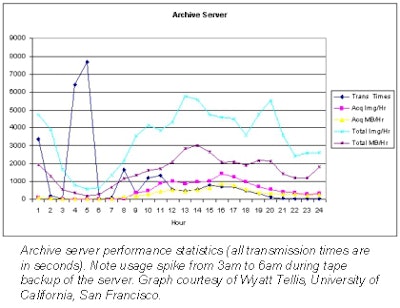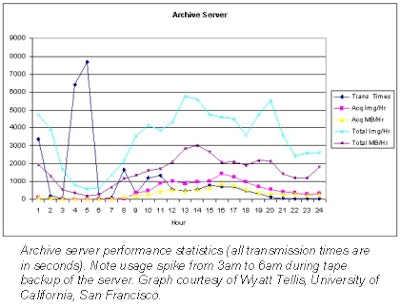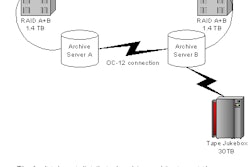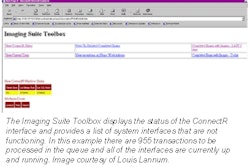
SALT LAKE CITY - The first stage of PACS evolution was all about getting a system into a facility. The next stage involves delivering a system that is both fault-tolerant, and fast enough to meet the needs of its users for images on demand.
Wyatt Tellis, a researcher in the biological and medical informatics graduate program and the department of radiology at the University of California, San Francisco, presented his group’s assessment of two PACS image-cache architectures at the SCAR meeting on Saturday.
Tellis teamed with UCSF colleague Dr. Katherine Andriole to examine the performance liabilities and assets of a distributed image-cache system vs. a centralized cache system. The duo used two PACS from Agfa Medical: an Impax R3.5 was configured as a distributed-cache system, and an Impax R4 was designed as a centralized cache PACS.
Each cache system had one six-CPU 366-MHz UltraSparc (Sun Microsystems, Mountain View, CA) server with 2 GB of RAM running either Oracle 7 or 8 (Oracle, Redwood Shores, CA) database management software as the PACS controller. They each had a 1 terabyte (TB) magneto-optical disk (MOD) jukebox functioning as a long-term archive, three acquisition gateways, and multiple display stations. The physical infrastructure of the networks is 100-Mbit asynchronous transfer mode (ATM).
With the centralized cache, a single centrally located repository stores all newly acquired images. Then, each display station pulls images from the cache on demand whenever the image is displayed. With the distributed cache, each workstation stores a local copy of an image for display.
The researchers settled on three performance measurements for the distributed cache PACS:
- Total image transfer load (calculated by tracking the number of images arriving at the device in an hour).
- Acquisition transfer load (calculated in a similar manner as the image transfer load, but only taking into account images from studies done in the current day).
- Acquisition routing times (calculated by measuring the length of time it took to route newly acquired images from a gateway to the destination device).
(The centralized cache system did not undergo full load testing as the group is in the process of installing the complete clinical system.)
 |
Tellis discovered that the archive server placed the highest loads on each system. Early morning and midday hours showed high activity due to prefetching of images in the morning and manual retrieval of those images for study and review in the afternoon. In addition, there was a dramatic spike in activity from 3 to 6 a.m. that Tellis attributes to the daily backup of the database.
According to Tellis, a centralized PACS is a simple design that reduces the controller load because it doesn’t track image location across multiple caches. However, this may result in larger spikes in network traffic, because the distributed design allows for a more constant image-transfer, and thus network, load.
He also noted that even though both systems have a central controller, the centralized cache architecture creates a central point of failure.
"Because all images are stored in a single cache location, the failure of this cache brings all operations within the PACS to a halt," said Tellis. "However, a distributed system can compensate for the failure of one cache by using other caches that contain copies of the failed cache’s images," he added.
Tellis and Andriole’s research have led them to conclude that a hybrid architecture of both cache designs may be the most efficient PACS implementation. They are investigating an "autonomous" design that has a distributed cache and no controller. Tellis believes that by distributing the application logic, an autonomous PACS architecture can provide increased fault tolerance and uptime.
By Jonathan S. Batchelor
AuntMinnie.com staff writer
May 6, 2001
Related Reading
Team tracks image data demand to optimize PACS architecture, February 9, 2001
Strategic planning key to PACS installations at imaging centers, August 21, 2000
Click here to post your comments about this story in our PACS Digital Community. Please include the headline of the article in your message.
Copyright © 2001 AuntMinnie.com



















